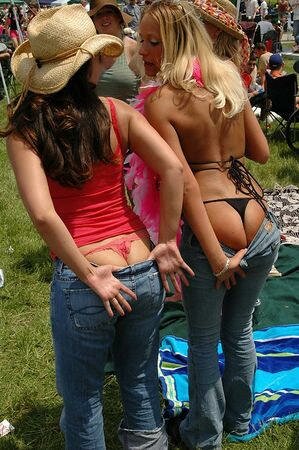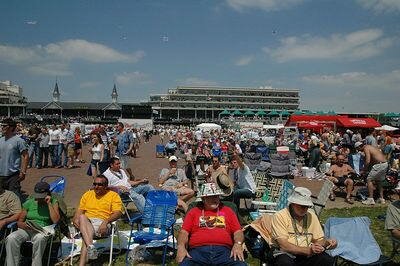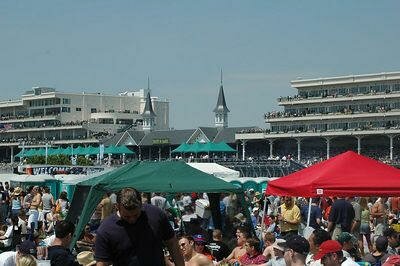|
 Since the 1st running of the Kentucky Derby in 1875, the 40-acre Churchill Downs infield has been a gathering place to exercise the first rite of spring. Since the 1st running of the Kentucky Derby in 1875, the 40-acre Churchill Downs infield has been a gathering place to exercise the first rite of spring.
Attracting folks from all over the country, the infield at Churchill Downs regularly becomes home to 80,000 fans for Kentucky Oaks and Kentucky Derby days. For many, one visit to the infield is enough to last a lifetime (about all you may see of the races is a cloud of dust and a flash of silks); others come back year after year, graduating from the fun of their youthful college days to family picnics with the little ones.
Whatever the activity, the infield revelry on Derby Day ranks as one of America's great parties.
"That whole thing will be jammed with people; fifty thousand or so, and most of them staggering drunk. It's a fantastic scene--thousands of people fainting, crying, copulating, trampling each other, and fighting with broken whiskey bottles."
-Native son Hunter S. Thompson,
Photo By Ryan Armbrust - Sniperphotography.com
History of the Churchill Downs infield
Since the first running of the Kentucky Derby in 1875, the infield has served as one of the main ingredients in the recipe which has helped create Derby success.
The legendary Col. Matt J. Winn viewed the first Derby from the infield, atop his father's wagon. The experience led Winn on a path from clothier to Churchill Down's most prominent president and promoter of the Kentucky Derby.
Steeplechase racing was periodically held in the infield during the early years of Churchill Downs. The first steeplechase event took place May 18, 1882 over the course of hurdles, stone walls, and water jumps.
Tunnels were constructed under the track in 1937 to provide better patron access to the infield. An additional tunnel, large enough to facilitate semi-trucks, was added in 1985 when the turf course was built.

Photo By Ryan Armbrust - Sniperphotography.com
Over the years the infield has also served a variety of other purposes beyond racing. In 1910, the first recorded flight in Kentucky took place in the infield. Legendary aviator, Glenn Curtiss, who founded Curtiss-Wright Aviation, shipped a plane to Louisville via freight train. After assembling the flying machine in the infield, Curtiss lifted off and flew around the track at a speed reported to be 60 mph.
During World War I, in the spring of 1918, with the country experiencing a potato shortage, a crop was planted in the Churchill infield. One thousand bushels were harvested and auctioned off, and the money was donated to the Red Cross.
During the 1942 Fall Meet, soldiers from Fort Knox and Bowman Field were housed in the infield in tents. The area was named "Camp Winn" in honor of Churchill Downs president Matt J. Winn.

Photo By Ryan Armbrust - Sniperphotography.com
The infield continues to serve a variety of purposes including: the Boy Scouts annual Scout-O-Rama, featuring over 3,000 scouts camping in the infield during the three-day event in April; the annual Operation Brightside Volleyball Tournament, to benefit the city's beautification program; and a variety of other special events.
** Special Thanks to Ryan for your wonderful photos!
|


